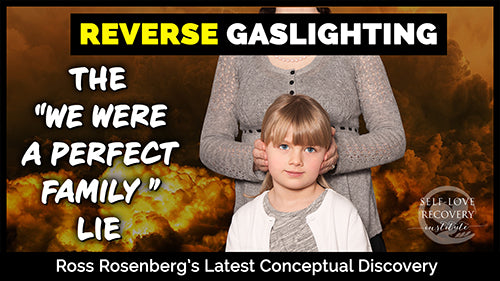
Written by Ross Rosenberg, M.Ed., LCPC, CADC
Self-Love Recovery Institute — President/CEO
Psychotherapist, Educator, Author, Expert Witness
If you’ve read my book, The Human Magnet Syndrome, you know I am constantly creating new concepts, examples, illustrations, or theories, especially those that relate to my Self-Love Recovery Treatment Program. This program was designed for people with Self-Love Deficit Disorder (SLDD), my updated term for codependency. Those with SLDD, according to my Human Magnet Syndrome theories, are unconsciously attracted to pathological narcissists, who in the beginning are dream lovers, but later hurt, neglect, deprive, and abuse them.
Most of my theoretical, conceptual, and practical discoveries come to me during sessions with my clients suffering from SLDD. For this article, I am sharing a session with an SLD—or Self-Love Deficient client (codependent), whose real name is not Sandra. In a recent psychotherapy session with Sandra, I kept digging for a childhood history of attachment trauma caused by a narcissistic and SLD parent. Since SLDD is inexorably tied to this childhood experience, I felt it to be odd that she reported only positive memories of her childhood and family. But as I discussed with her, there had to be an early childhood trauma experience that set her up to fall in love with and stay married for 37 years to her husband, who was a covert narcissist (narcissistic personality disorder with antisocial traits).
This session began with Sandra expressing confusion with my book, The Human Magnet Syndrome. She asked me if she was the exception to my theories since she had an uneventful childhood in a family that had few problems and parents who were loving. I naturally said no to her while explaining her dissociative-like presentation and her 20-plus years of obliviousness to her severely narcissistic husband.
Sandra seemed anxious and bewildered when I repeated my Human Magnet Syndrome theoretical explanations for the development of SLDD. I am sure I said the following statement three to four times: “It is simply impossible to be an SLD if you did not experience attachment trauma.” Sandra tried to recall memories that would indicate that she was raised by impaired parents in a dysfunctional family. She persisted, “I have no memories of my parents not getting along. Also, I cannot recall any dysfunction in our family… we all got along… and rarely argued. We had family dinners, went on nice vacations, and other fun stuff.” As a psychotherapist, I knew it was crucial to peel back the layers of memories to find out what was underneath an unrealistic, positive rendition of her parents, family, childhood, and her early mental health.
Over the next four sessions, we continued to explore her childhood memories and potential explanations for her semi-dissociated life, especially during her childhood. Because she couldn’t identify any traumatic events in her childhood or family, she was confused about the cause of her limited understanding of emotions/feelings and the fact that she always had been cautious and reserved in situations with people, especially those who were emotionally fluent.
After the fourth session, Sandra shared a story about her father’s lack of emotional expression, nurturing involvement with anyone in the family, and his aloof and “head in the clouds” personality type. With laser-focused questions, I uncovered a psychological profile of a man who showed no authentic interest in anyone, unless he was similarly interested, or it affected him. In these discussions, Sandra disclosed that her father never showed open or tacit expressions of fondness and nurturing.
Her father’s covert narcissism was neither expressed in front of the family nor at work. But she recalled many instances when people around him were anxious about disappointing him. This prompted me to explore if she had ever witnessed or been a victim of a narcissistic injury. She began to remember incidents when she was extremely anxious when asked about school, her grades, friends, and after-school activities. Pushing herself to remember even more, she landed on a memory of when she went on a fishing trip with her father. When her father caught a fish, he screamed, “Get the net!” Since Sandra was daydreaming, and not listening to her father, her hesitation to grab the net caused the fish to get away.
Sandra’s benign mistake triggered a rageful reaction in which her father got in her face, screaming, and saying repeatedly how much of a disappointment she was. Sandra began to cry when pulling the details out of this memory. Clearly, she had opened a long-closed door to her childhood memories. In that same session, she remembered additional incidents when she upset her father, who, in turn, gave her the very painful “silent treatment” and a facial expression of forever-lasting disappointment.
In the next few sessions, we turned our attention to her mother. Her initial memories seemed to me more like a 1950s sitcom in which the doting mother was doing everything right for all the people in the family while ignoring her own needs. This always-smiling and accommodating mother was too good to be true. Then, like with her father, she began to recall memories of her chronic anxiety and sadness, which we assumed was chronic depression. What struck me odd was Sandra’s statement, “Mom never got mad, or even disappointed… she was always there for us when we needed her.”
At this juncture of psychotherapy, I used “Stepford Family” as a term to describe her unnaturally calm and always loving, accommodating robot-like family. Incidentally, the film, “The Stepford Wives,” was about men who created robot duplicates of their wives so they could have the perfect accommodating and always-pleasing marriage and family experience. Although she was not fond of my “Stepford” comments, it provoked her to compare her family experience with her friend’s family. While her family was stoically calm and always smiling, her friend’s family had the normal ups and downs, squabbles, anger, and make-ups.
I asked Sandra if she ever experienced the normal teenager moments when her parents seemed to be oblivious to what was important to her, and her thoughts were turned inward toward her own point of view. Sandra responded again by not recalling any memories of teenage angst or her siblings behaving in such a developmentally appropriate, but annoying, manner.
Sandra sat quietly, looking confused and deep in thought. She then said, “Why are you trying so hard to make my healthy family into something it was not?” I responded by assuring her my diagnosis of her affective (emotional) limitations and mild dissociative state combined with her severely unhappy and dysfunctional relationship with her narcissistic parent strongly indicated that she was a victim of severe attachment trauma, which pointed back to having a pathologically narcissistic and SLD (codependent) parent. I assured her that if I thought she had a healthy childhood and appropriate loving, caring, and respectful parents, I would have no problem telling her.
She began to wonder if a “filter” was installed in her mind that kept any “bad” memories inside while only letting the “good” ones come out. This was our “eureka moment,” when she seemed to understand the truth of her statement! It was natural for me to follow up with a brief discussion of gaslighting, and the “filters” or false narratives a pathological narcissist can “install” without the victim knowing. This “healthy family” gaslit narrative seemed to explain why it was so hard to recall the lonely, anxious, and emotionally “famished” feelings of her youth. Using Sandra’s vernacular, her “filter” explained how everyone was gaslit to believe the untrue beliefs of a happy, harmonious, and supportive family.
Now, memories of her family’s dysfunction, especially her father's quietly hidden narcissism, began to bubble up. The most striking of all her memories was when she was a freshman in college. At age 18, after a party with her friends, she drove home completely inebriated. She vaguely remembered parking on the grass instead of the parking lot, having unopened beer cans in her back seat, and a puddle of her vomit. The next day, her parents paid her a surprise visit. When awakened, she was noticeably hungover, bleary-eyed, and had remnants of vomit on her shirt.
Despite being visibly hungover, her parents made no comments and asked no questions. After spending most of the morning and afternoon together, they went home. This is when she noticed her car was appropriately parked and any evidence of her drinking binge was sanitized from her car. Sandra asked, “Is this odd, or does this mean I have ‘cool’ parents?” Before I could answer, she replied, “Oh yeah, this is an example of them trying to hide any evidence of my obvious problematic and dangerous drinking.”
This was when I created the term “Reverse Gaslighting,” to explain the phenomenon about which we had been talking. Just like traditional gaslighting, there was a focused and selfish effort to manipulate the environment to create a false belief in a reality that was manufactured. In her case, her father—and to some degree, her mother—clearly manipulated her childhood and adolescent perceptions to make her believe what was obviously dysfunctional was healthy. Sandra now understood how and why her parents ignored or whitewashed any negative interactions so that the “perfect family” and “perfect daughter” narrative could stay intact.
Hence, my reverse gaslighting discovery provided Sandra and a handful of other clients with a logical explanation for their almost too-good-to-be-true memories of their childhood and family. By her parents strategically fabricated evidence of positive mental and relational health, perpetuating the self-serving “no problems” narratives, they could enjoy the freedom of not being held accountable for the actual harm for which they were responsible. This almost invisible and difficult-to-detect form of child abuse causes similar psychological impairment that can create the foundation for adult Self-Love Deficit Disorder. Hence, reverse gaslighting is just as toxic, damaging, limiting, and harmful as traditional gaslighting.


0 comments